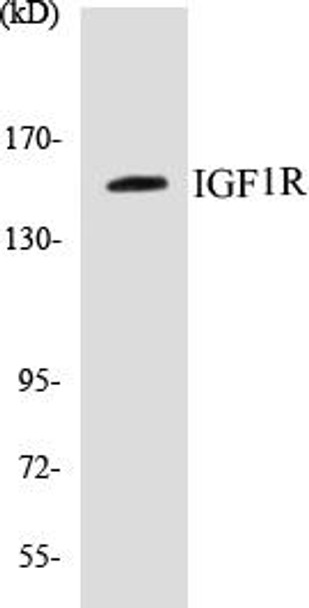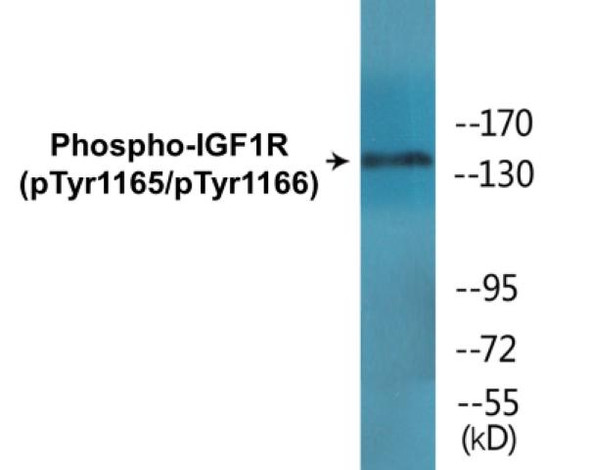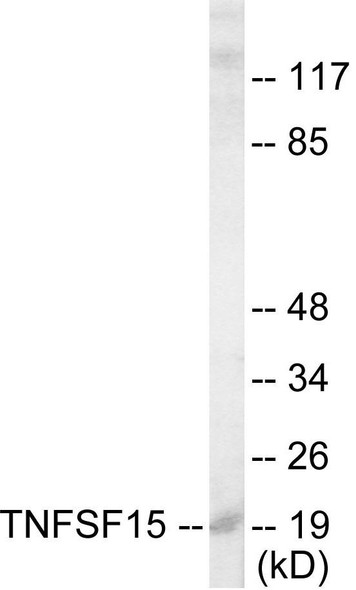IGF1R Colorimetric Cell-Based ELISA Kit
- SKU:
- CBCAB00704
- Product Type:
- ELISA Kit
- ELISA Type:
- Cell Based
- Reactivity:
- Human
- Mouse
- Rat
- Detection Method:
- Colorimetric
Description
| Product Name: | IGF1R Colorimetric Cell-Based ELISA |
| Product Code: | CBCAB00704 |
| ELISA Type: | Cell-Based |
| Target: | IGF1R |
| Reactivity: | Human, Mouse, Rat |
| Dynamic Range: | > 5000 Cells |
| Detection Method: | Colorimetric 450 nmStorage/Stability:4°C/6 Months |
| Format: | 96-Well Microplate |
The IGF1R Colorimetric Cell-Based ELISA Kit is a convenient, lysate-free, high throughput and sensitive assay kit that can detect IGF1R protein expression profile in cells. The kit can be used for measuring the relative amounts of IGF1R in cultured cells as well as screening for the effects that various treatments, inhibitors (ie siRNA or chemicals), or activators have on IGF1R.
Qualitative determination of IGF1R concentration is achieved by an indirect ELISA format. In essence, IGF1R is captured by IGF1R-specific primary antibodies while the HRP-conjugated secondary antibodies bind the Fc region of the primary antibody. Through this binding, the HRP enzyme conjugated to the secondary antibody can catalyze a colorimetric reaction upon substrate addition. Due to the qualitative nature of the Cell-Based ELISA, multiple normalization methods are needed:
| 1. | A monoclonal antibody specific for human GAPDH is included to serve as an internal positive control in normalizing the target absorbance values. |
| 2. | Following the colorimetric measurement of HRP activity via substrate addition, the Crystal Violet whole-cell staining method may be used to determine cell density. After staining, the results can be analysed by normalizing the absorbance values to cell amounts, by which the plating difference can be adjusted. |
| Database Information: | Gene ID: 3480, UniProt ID: P08069/P06213, OMIM: 147370/270450, Unigene: Hs.643120/Hs.653608/Hs.714012 |
| Gene Symbol: | IGF1R |
| Sub Type: | None |
| UniProt Protein Function: | IGF1R: a receptor tyrosine kinase that binds insulin-like growth factor 1 (IGF1) with a high affinity and IGF2 with a lower affinity. Functions as an anti-apoptotic agent by enhancing cell survival. Can play a critical role in transformation events. Cleavage of the precursor generates alpha and beta subunits. Tetramer of 2 alpha and 2 beta chains linked by disulfide bonds. The alpha chains contribute to the formation of the ligand- binding domain, while the beta chain carries the kinase domain. Interacts with PIK3R1 and with the PTB/PID domains of IRS1 and SHC1 in vitro when autophosphorylated on tyrosine residues. Mutated in rare cases of pre- and post-natal growth retardation. One SNP associated with increased human longevity. Increased expression of IGF1R and other pathway members associated with progression and malignancy in a range of cancers. Inhibitors: AG1024, AEW541. |
| UniProt Protein Details: | Protein type:Protein kinase, tyrosine (receptor); Protein kinase, TK; Kinase, protein; Membrane protein, integral; EC 2.7.10.1; TK group; InsR family Chromosomal Location of Human Ortholog: 15q26.3 Cellular Component: integral to plasma membrane; intracellular membrane-bound organelle; membrane; plasma membrane; receptor complex Molecular Function:ATP binding; identical protein binding; insulin binding; insulin receptor binding; insulin receptor substrate binding; insulin-like growth factor binding; insulin-like growth factor I binding; insulin-like growth factor receptor activity; phosphoinositide 3-kinase binding; protein binding; protein-tyrosine kinase activity Biological Process: brain development; epidermis development; exocrine pancreas development; immune response; inactivation of MAPKK activity; insulin receptor signaling pathway; insulin-like growth factor receptor signaling pathway; male sex determination; mammary gland development; negative regulation of apoptosis; negative regulation of protein kinase B signaling cascade; negative regulation of transcription factor activity; phosphoinositide 3-kinase cascade; phosphoinositide-mediated signaling; positive regulation of cell migration; positive regulation of cell proliferation; positive regulation of DNA replication; positive regulation of MAPKKK cascade; positive regulation of mitosis; positive regulation of protein kinase B signaling cascade; protein amino acid autophosphorylation; protein tetramerization; regulation of JNK cascade; signal transduction Disease: Insulin-like Growth Factor I, Resistance To |
| NCBI Summary: | This receptor binds insulin-like growth factor with a high affinity. It has tyrosine kinase activity. The insulin-like growth factor I receptor plays a critical role in transformation events. Cleavage of the precursor generates alpha and beta subunits. It is highly overexpressed in most malignant tissues where it functions as an anti-apoptotic agent by enhancing cell survival. Alternatively spliced transcript variants encoding distinct isoforms have been found for this gene. [provided by RefSeq, May 2014] |
| UniProt Code: | P08069 |
| NCBI GenInfo Identifier: | 124240 |
| NCBI Gene ID: | 3480 |
| NCBI Accession: | P08069.1 |
| UniProt Secondary Accession: | P08069,Q14CV2, Q9UCC0, B1B5Y2, |
| UniProt Related Accession: | P08069 |
| Molecular Weight: | |
| NCBI Full Name: | Insulin-like growth factor 1 receptor |
| NCBI Synonym Full Names: | insulin like growth factor 1 receptor |
| NCBI Official Symbol: | IGF1R |
| NCBI Official Synonym Symbols: | IGFR; CD221; IGFIR; JTK13 |
| NCBI Protein Information: | insulin-like growth factor 1 receptor |
| UniProt Protein Name: | Insulin-like growth factor 1 receptor |
| UniProt Synonym Protein Names: | Insulin-like growth factor I receptor; IGF-I receptor |
| Protein Family: | Insulin-like growth factor 1 receptor |
| UniProt Gene Name: | IGF1R |
| UniProt Entry Name: | IGF1R_HUMAN |
| Component | Quantity |
| 96-Well Cell Culture Clear-Bottom Microplate | 2 plates |
| 10X TBS | 24 mL |
| Quenching Buffer | 24 mL |
| Blocking Buffer | 50 mL |
| 15X Wash Buffer | 50 mL |
| Primary Antibody Diluent | 12 mL |
| 100x Anti-Phospho Target Antibody | 60 µL |
| 100x Anti-Target Antibody | 60 µL |
| Anti-GAPDH Antibody | 60 µL |
| HRP-Conjugated Anti-Rabbit IgG Antibody | 12 mL |
| HRP-Conjugated Anti-Mouse IgG Antibody | 12 mL |
| SDS Solution | 12 mL |
| Stop Solution | 24 mL |
| Ready-to-Use Substrate | 12 mL |
| Crystal Violet Solution | 12 mL |
| Adhesive Plate Seals | 2 seals |
The following materials and/or equipment are NOT provided in this kit but are necessary to successfully conduct the experiment:
- Microplate reader able to measure absorbance at 450 nm and/or 595 nm for Crystal Violet Cell Staining (Optional)
- Micropipettes with capability of measuring volumes ranging from 1 µL to 1 ml
- 37% formaldehyde (Sigma Cat# F-8775) or formaldehyde from other sources
- Squirt bottle, manifold dispenser, multichannel pipette reservoir or automated microplate washer
- Graph paper or computer software capable of generating or displaying logarithmic functions
- Absorbent papers or vacuum aspirator
- Test tubes or microfuge tubes capable of storing ≥1 ml
- Poly-L-Lysine (Sigma Cat# P4832 for suspension cells)
- Orbital shaker (optional)
- Deionized or sterile water
*Note: Protocols are specific to each batch/lot. For the correct instructions please follow the protocol included in your kit.
| Step | Procedure |
| 1. | Seed 200 µL of 20,000 adherent cells in culture medium in each well of a 96-well plate. The plates included in the kit are sterile and treated for cell culture. For suspension cells and loosely attached cells, coat the plates with 100 µL of 10 µg/ml Poly-L-Lysine (not included) to each well of a 96-well plate for 30 minutes at 37°C prior to adding cells. |
| 2. | Incubate the cells for overnight at 37°C, 5% CO2. |
| 3. | Treat the cells as desired. |
| 4. | Remove the cell culture medium and rinse with 200 µL of 1x TBS, twice. |
| 5. | Fix the cells by incubating with 100 µL of Fixing Solution for 20 minutes at room temperature. The 4% formaldehyde is used for adherent cells and 8% formaldehyde is used for suspension cells and loosely attached cells. |
| 6. | Remove the Fixing Solution and wash the plate 3 times with 200 µL 1x Wash Buffer for five minutes each time with gentle shaking on the orbital shaker. The plate can be stored at 4°C for a week. |
| 7. | Add 100 µL of Quenching Buffer and incubate for 20 minutes at room temperature. |
| 8. | Wash the plate 3 times with 1x Wash Buffer for 5 minutes each time. |
| 9. | Add 200 µL of Blocking Buffer and incubate for 1 hour at room temperature. |
| 10. | Wash 3 times with 200 µL of 1x Wash Buffer for 5 minutes each time. |
| 11. | Add 50 µL of 1x primary antibodies (Anti-IGF1R Antibody and/or Anti-GAPDH Antibody) to the corresponding wells, cover with Parafilm and incubate for 16 hours (overnight) at 4°C. If the target expression is known to be high, incubate for 2 hours at room temperature. |
| 12. | Wash 3 times with 200 µL of 1x Wash Buffer for 5 minutes each time. |
| 13. | Add 50 µL of 1x secondary antibodies (HRP-Conjugated AntiRabbit IgG Antibody or HRP-Conjugated Anti-Mouse IgG Antibody) to corresponding wells and incubate for 1.5 hours at room temperature. |
| 14. | Wash 3 times with 200 µL of 1x Wash Buffer for 5 minutes each time. |
| 15. | Add 50 µL of Ready-to-Use Substrate to each well and incubate for 30 minutes at room temperature in the dark. |
| 16. | Add 50 µL of Stop Solution to each well and read OD at 450 nm immediately using the microplate reader. |
(Additional Crystal Violet staining may be performed if desired – details of this may be found in the kit technical manual.)






